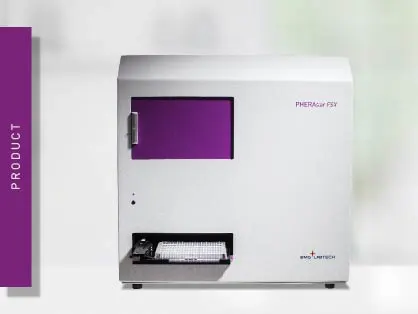
PHERAstar FSX
Powerful and most sensitive HTS plate reader
Steven van Helden, Chief Technology Officer at Pivot Park Screening Centre (PPSC), relies on efficient microplate readers for effective hit discovery. Here he discusses innovation in drug discovery and the future of screening technology.
In what way is the drug discovery environment changing and how does it affect your work?
Open innovation and knowledge exchange have become topics of great relevance in the last couple of years and have proven to accelerate drug discoveries. At PPSC we’ve been at the forefront of this development since our establishment in 2012. Our role as the central screening centre for the European Lead Factory, initiated by the Innovative Medicines Initiative (IMI), is a perfect example of how combining knowledge, expertise and facilities results in a boost to drug discoveries and a tremendous broadening of knowledge for all parties involved. The recent European PHERAstar User Meeting that was hosted at the Pivot Park campus in Oss, the Netherlands and organised by BMG LABTECH, is also an example of this trend. Bringing users together and facilitating knowledge exchange will lead the sector to the next level.
What role do microplate readers play in the services offered by PPSC?
The microplate readers are of utmost importance in the high-throughput screening workflow at PPSC. They measure the signal that is translated into a conclusion about the compound under investigation; answering the question: is this compound a useful starting point for the development of a new medicine? And this is our core business: to help customers find new starting points. Obviously, the quality and performance of these microplate readers are crucial in our business.
What microplate reader requirements are needed to keep up with your screening necessities?
Besides quality at the highest level, we consider efficiency of great importance. Reducing the amount of resources needed to deliver the best results is an aspect we focus on in the continuous refinement of our screening processes. The PHERAstar FSX microplate readers have contributed significantly to this process due to a large decrease in measurement time and a higher sensitivity, resulting in the use of smaller amounts of reagents. The fact that BMG LABTECH is able to provide us with quick and thorough support makes them a reliable partner to work with.
You recently invested in BMG LABTECH´s PHERAstar FSX as a core screening instrument; what supplier criteria did you use in your evaluation?
We are very critical when it comes to suppliers of equipment in our high-throughput screening infrastructure. The fact that BMG LABTECH has a good track record regarding customers for their systems was important for us. Besides this, we believe a good relationship and optimal support from our suppliers is key to deliver the best results to our customers. The fact that BMG LABTECH has a broad experience provides us with the opportunity to ask them for input on both basic and more complicated cases. We’ve been using our new microplate readers for six months and have asked everyone working with them to evaluate the system critically. This has resulted in very positive feedback.
About Steven van Helden
Steven van Helden has a 25-year history in the pharmaceutical industry and was a fundamental actor in the founding of PPSC. Using chemoinformatics and database technologies, he has contributed to a range of research projects, mainly in the field of nuclear receptors. As head of Screening and Technologies, he set up a new infrastructure for in vitro screening, ran screening operations for nine years and, after two US takeovers, contributed to a screening strategy for the new combined company.

Powerful and most sensitive HTS plate reader